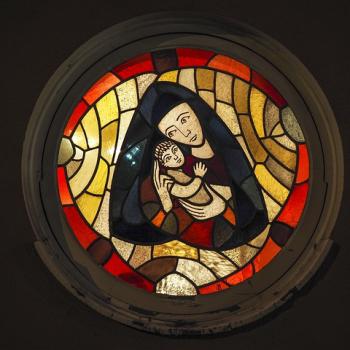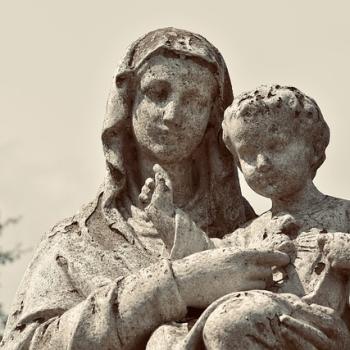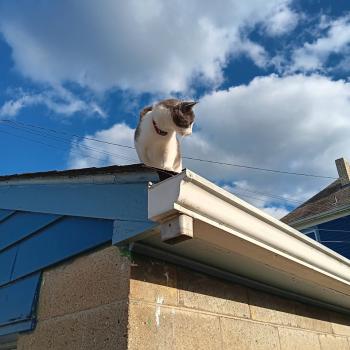
It’s an anxious time.
The New Year and the dead of winter are always anxious times. Every time of year is anxious for me, but these times in particular.
We covered in my last blog post that I seem to be struggling with PTSD. I’ve also often suffered from anxiety and occasional bouts of obsessive-compulsive disorder, partly because of my undiagnosed poly-cystic ovary syndrome and partly because of my family’s time in a particularly toxic sect of the Charismatic Renewal. We were taught that demons were everywhere, and that the slightest mistake could leave you with a demonic possession. Demons inhabited people, television shows, video games, family genealogy, and random objects, and they were extremely contagious. I was constantly muttering Hail Marys under my breath to repel demonic contamination. We believed that God was easily angered and would permit the demons to take you over if you sinned, so I was extra scrupulous and took between twenty minutes and an hour to make an examination of conscience every night. We believed in prophesies and Words from the Lord and apparitions, any anxious thing that crossed our minds when we prayed. We believed in catastrophes, chastisements and the upcoming Three Days of Darkness. We believed that God sometimes smites people with terrible suffering so they can offer it up, to defer or postpone chastisements. We believed God always sends you the suffering you like least, so it can be a true sacrifice, and that that was a good and loving thing for our Father in Heaven to do.
We thought that was Christianity.
All of this crescendoed into a terrible scare when I was eleven.
I had just read a book about Catherine of Sienna, a saint I still love and admire. I now think of her as a wonderful, generous, passionate woman who cared for the poor and who spoke truth to power, but was also severely mentally ill. She really did have mystical experiences of Christ, Christ probably really did work miracles through her, but she also suffered from anorexia at a minimum and perhaps other conditions. It was probably the anorexia that killed her in the end. And when she died, Christ brought her to Heaven where she intercedes for us. That’s how you get to be a saint, after all: by Christ bringing you to Heaven. But that’s not how the book presented Saint Catherine of Sienna. It presented her as someone completely unproblematic. It painted every weird and eccentric thing she did as a good thing and a sign of her sanctity, and I believed it. It sounded like the kind of Christianity I’d been taught. At the end of the book, when Saint Catherine was telling all of her followers she was going to die “within the year” and offer her death for the Church, this was also painted as a good thing. She slowly and painfully withered away by inches, lying on bare boards, and this was also good. This was exactly what God wanted to happen.
I wondered if God wanted that for me.
I wondered if God wanted me to die “within the year” and offer my suffering for the Church. I completely missed the part where Saint Catherine was starving herself to death and thought he was just going to bleed me out bit by bit, as a special grace.
It sounded like a horrible fate. I didn’t want to do it. I wanted to live to be a grown-up and be in Shakespeare plays and maybe go to medical school or become a nun. But I remembered my mother telling me God always gives you the suffering you like least, so it can be a true sacrifice.
The thing I would like least was to die within the year.
I figured that meant it was God’s will that I die within the year. And I honestly thought that God would do that to me within the year, because it sounded terrible. People raised in these types of religious sects will tell you this is the kind of muddle your mind can get into when you’re fed those kinds of lies.
For the next several months, I tried not to think about my sacrifice. I played with the other misfit nerdy girls on the Catholic school playground and hid from bullies. I tried to pray as devoutly as I could at Sunday Mass and was terrified I’d made God angry if I got distracted. I said a Hail Mary in my mind whenever I brushed up against someone, in case that person was possessed. I took between twenty minutes and an hour to examine my conscience before bed. And I wished the end of the year would never come, but it did. It loomed up closer and closer. Fall came and then winter, time for God to collect on my promise.
At a few minutes before midnight on December thirty-first, I found myself crying, fully believing that my heart was going to stop at any second and that this would be a good thing. And then the clock struck midnight, and I was still alive. Confused. Shaky. Traumatized. Wondering when God would come back to take what I promised him. But still alive, and relieved, and excited for the new year.
Christ was with me in all of that– not demanding my life as a sacrifice, but suffering with me and waiting for me to be in a position to learn that it wasn’t Him. The Charismatic Renewal, or at least its representatives that I knew, was slandering Him and blaspheming His name to hurt and control people like me. And they still do.
That was in the beginning of 1996, when I’d just turned eleven years old. Later that month, my anxiety reached such a fever pitch that I had to be taken out of school for a few months, and then my family began homeschooling. I’ve struggled with it ever since.
I’m thirty-seven now. I’ve cut ties with so much of my past. I’m in the awkward position of being a person with religious trauma who writes about it openly and calls out spiritual abuse, but still believes in Christ and wants to practice a non-toxic Christianity. Most of the people I know with religious trauma have moved on from organized religion and I’m not better than they are, but this is the particular path I’m on.
My daughter, Rosie, will turn eleven in 2022– the same age I was when I had my terrible breakdown. I’ve homeschooled her with a hodgepodge of different, mostly secular, methods rather than trying the local Catholic schools. I’ll never be quite sure that that’s the best thing for her education, but it is what it is. We still practice Catholicism, but we stay away from anything to do with the Charismatic Renewal. We drive to the Friendship Room to stuff the free pantry together and learn about God as we do. I teach her that saints are humans, flawed and capable of error like anyone, but exemplary in some ways. I refuse to teach her the mumbo jumbo of my childhood. She doesn’t believe in demonic possession. She’s never been to the site of an alleged Marian apparition. She’s never heard of the Three Days of Darkness. I told her that Christ came down to suffer with us and bring our suffering into the life of God, rather than teaching her that suffering is something God delights in. I’ve gotten so many things wrong, but I’m proud of that.
Rosie’s notions about what God expects are different than the ones I grew up with. “Being a Christian means living the life you find yourself in, with Christ,” I tell her. “Find some prayers you can say, and find a liturgy to go to on Sunday, and find ways to help the people in need in your community. That’s how to be a Christian.” And I tell the same thing to myself.
I don’t always believe myself, but it’s something I keep saying anyway.
Every year when fall wears itself out and the dead of winter comes, I can feel the anxiety rising. It certainly did this year, for many good reasons, but I think it’s also a memory of a past trauma. It always is. When my neighbor gave her bizarre performance on Christmas Eve, it triggered a bout of panic I was going to fall into one way or another. I was anxious for days, and I am still anxious.
This year we did even less than usual to celebrate New Years’ Eve. Michael walked out to the grocery store and Rosie and I picked him up in the car afterwards. We looked at the remaining Christmas lights. I sat up in the living room until midnight and afterwards– first afraid and anxious, remembering past trauma, and then surprised and relieved to have yet again lived into another year. And I sang and celebrated with my online friends. And Christ was with me.
I went to bed.
I woke up late, in the nearly-noon twilight of a January Steubenville drizzle, and Christ was with me. We went to a vigil Mass, and He came to meet me there. I went to an Orthodox liturgy to hear the beautiful chants the next morning, and there He was again. Later that holiday weekend, I found out that the Friendship Room needed to close unexpectedly for ten days due to the Omicron variant, and that they were asking for blankets. So I made a mental note to get them one, and Christ will be there when I do.
Christ is also with me in my anxiety.
It doesn’t have to be more complicated than that.
Image via Pixabay
Mary Pezzulo is the author of Meditations on the Way of the Cross and Stumbling into Grace: How We Meet God in Tiny Works of Mercy.
Steel Magnificat operates almost entirely on tips. To tip the author, visit our donate page.













